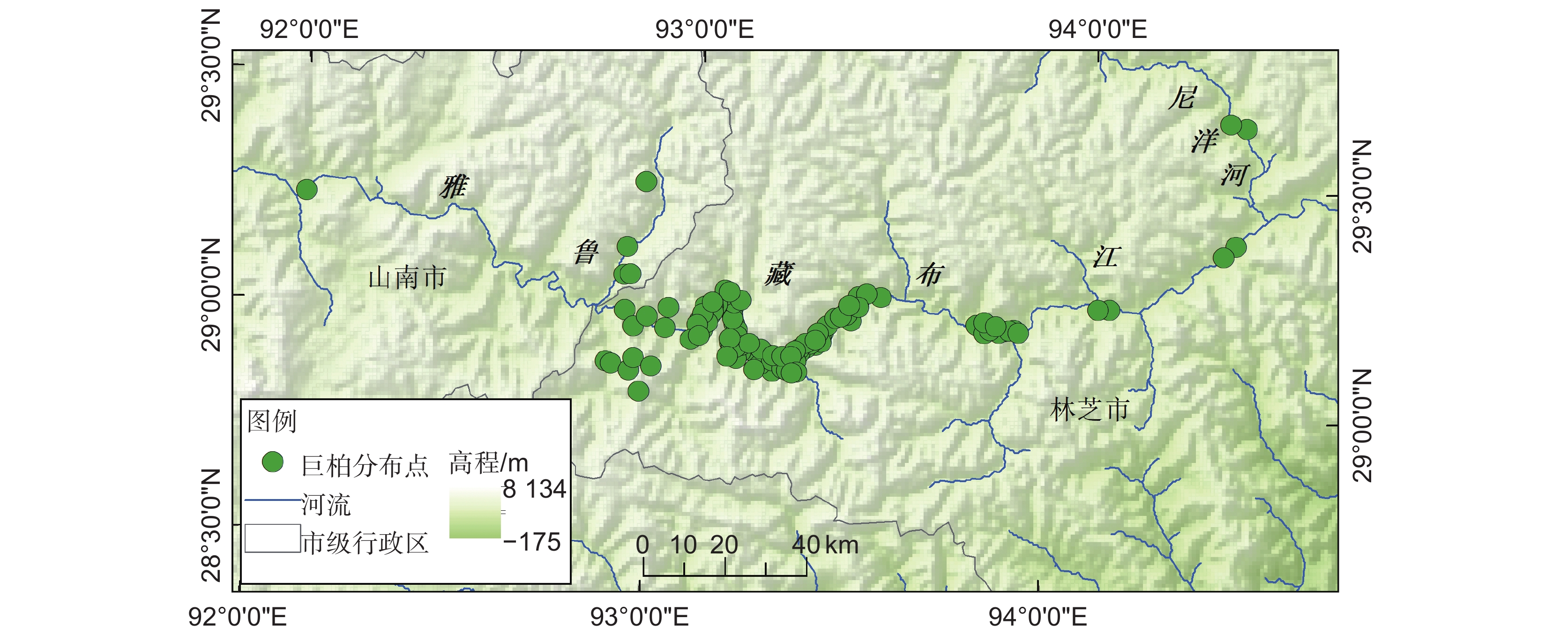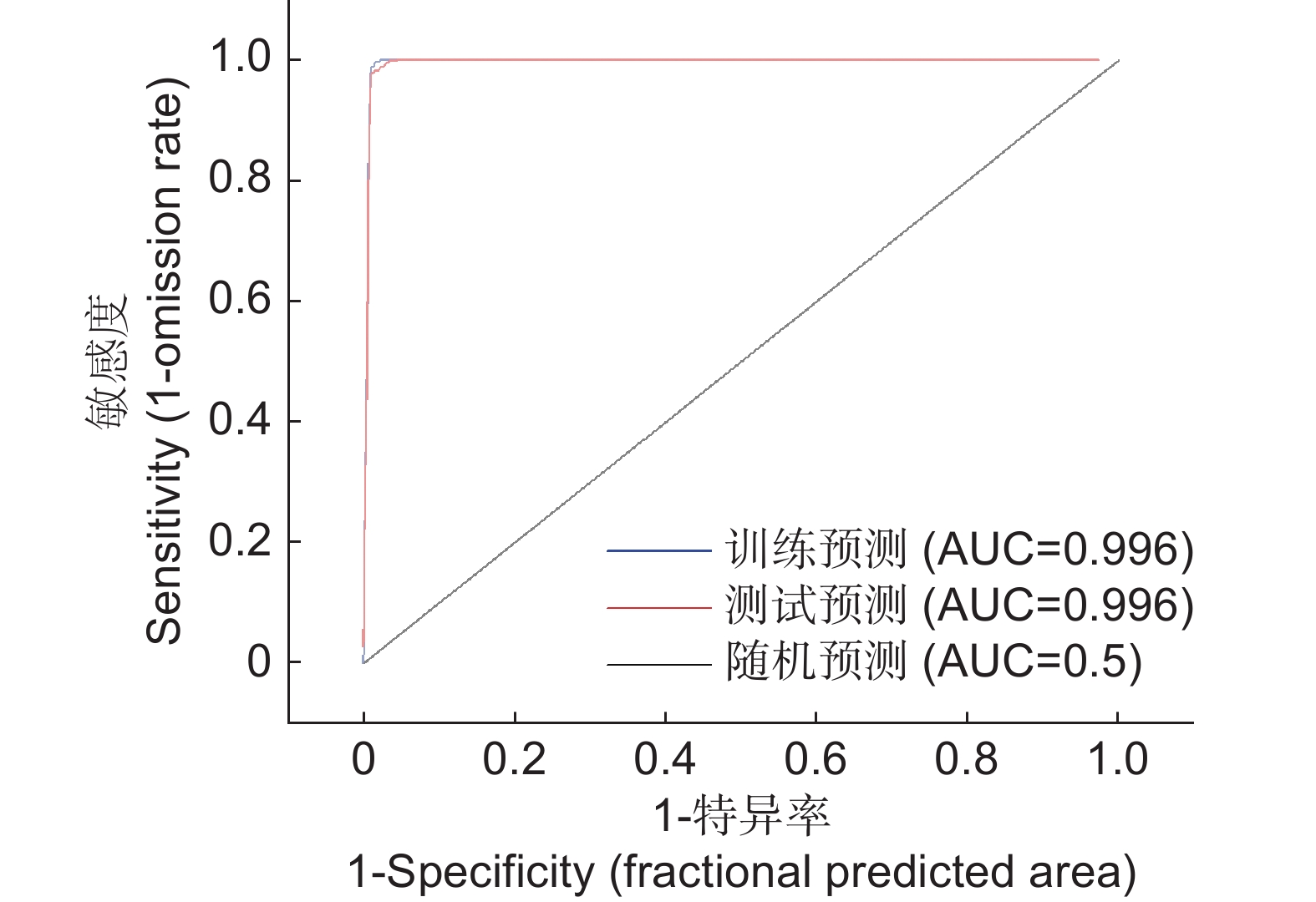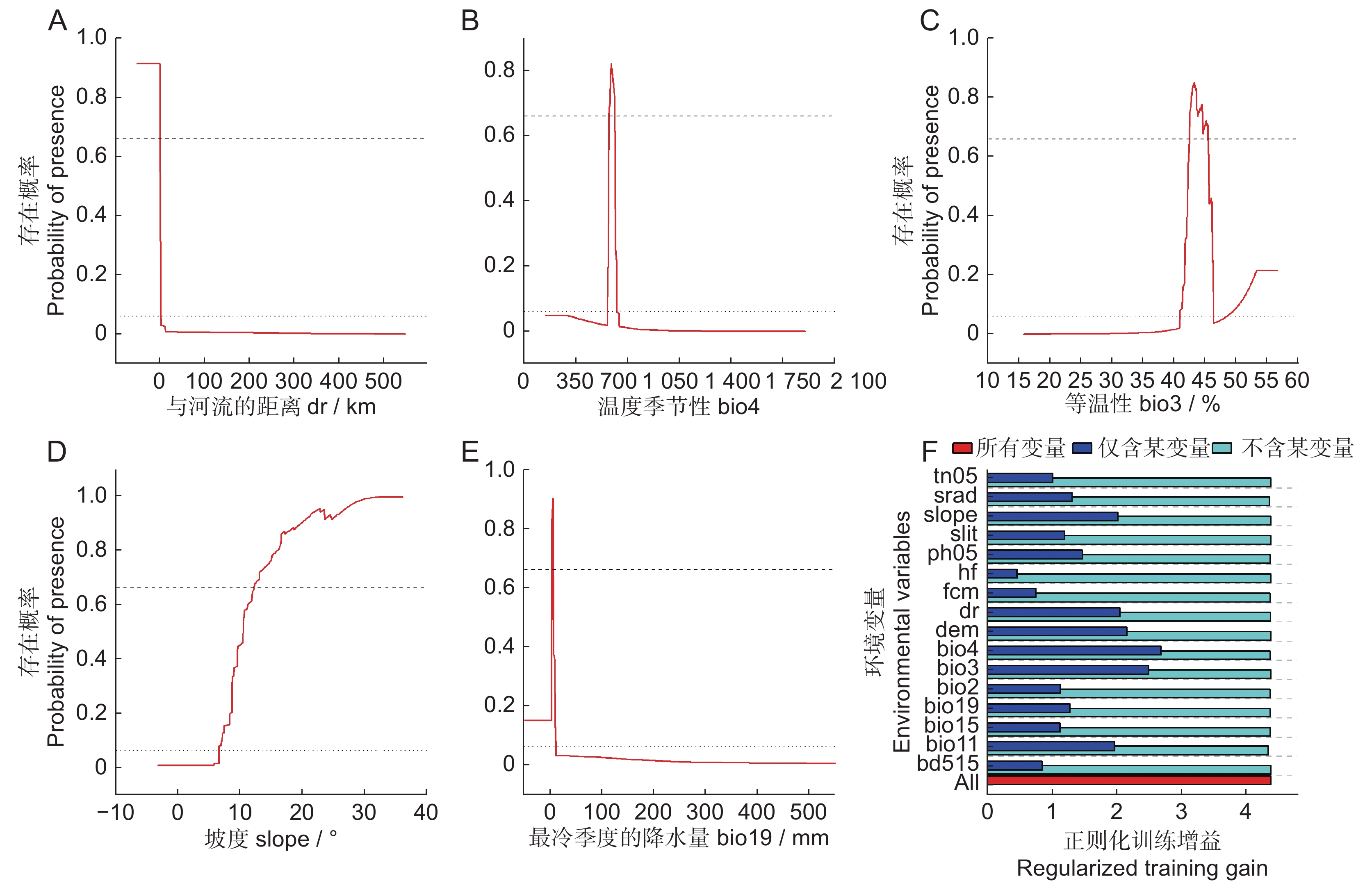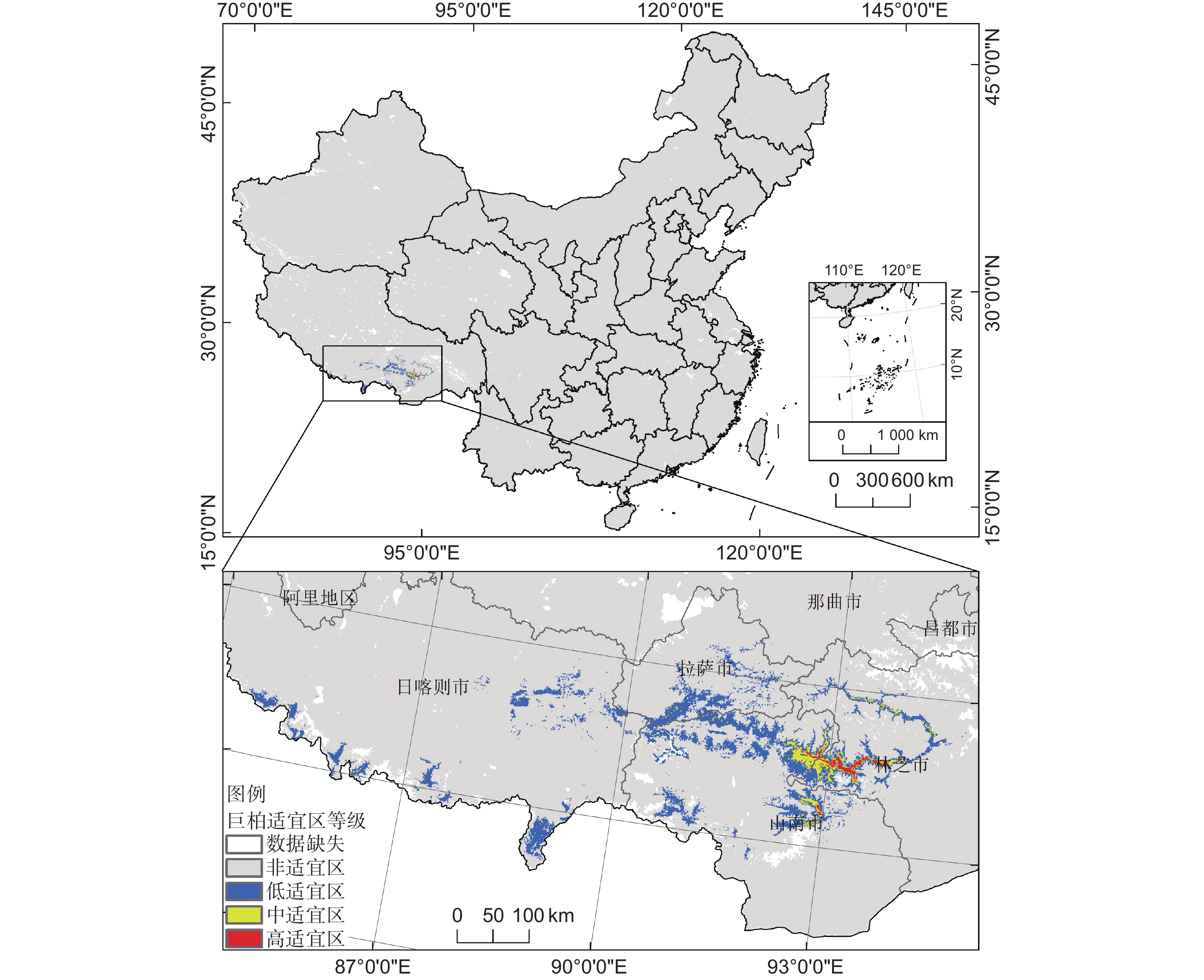Prediction of potential distribution of Cupressus gigantea W. C. Cheng & L. K. Fu in China based on optimized MaxEnt modeling
-
摘要:
巨柏(Cupressus gigantea W. C. Cheng & L. K. Fu)是西藏特有种,国家一级保护植物。本研究基于R软件“kuenm”包优化模型参数,建立最优MaxEnt模型,预测了全国范围内巨柏的潜在适宜分布区,并结合贡献率和折刀测验分析了影响其分布的主导环境变量。结果显示,优化模型的表现效果较好,相比默认参数模型,降低了模型的复杂度,提高了模拟预测精度。与河流的距离、温度季节性变化标准差、等温性、坡度、最冷季度降水量是影响巨柏分布的主导环境变量。巨柏在我国的潜在适宜分布区集中在西藏和四川,西藏的林芝、山南、拉萨和日喀则占据了全部中适宜区(2 298 km2)和高适宜区(746 km2),其中高适宜区只分布在林芝(563 km2)和山南(183 km2),约占西藏总面积的0.062%。朗县-米林市的高适宜区为巨柏潜在生境分布的核心地段,建议于此区域优先开展巨柏保护工作。
Abstract:Cupressus gigantea W. C. Cheng & L. K. Fu, a tree species endemic to Tibet and classified as a national first-class protected species in China, requires clear delineation of its potential suitable distribution for effective conservation, introduction, and breeding programs. This study established the MaxEnt model, using the “kuenm” R package to optimize model parameters, to predict the potential distribution of C. gigantea across China. Environmental variables influencing distribution were analyzed through percent contribution and Jackknife tests. The optimized model demonstrated superior predictive accuracy and reduced complexity compared to the default parameter model. Key factors influencing the distribution of C. gigantea included distance from rivers, temperature seasonality, isothermality, slope, and precipitation during the coldest quarter. Predicted suitable distribution areas were primarily located in Tibet and Sichuan, with the cities of Nyingchi, Lhoka, Lhasa, and Rikaze in Tibet encompassing the entirety of moderately suitable (2 298 km2) and highly suitable areas (746 km2). The high suitability area was exclusively distributed in Nyingchi (563 km2) and Lhoka (183 km2), representing about 0.062% of the total area of Tibet. The corridor between Lang County and Milin County emerged as the core habitat for C. gigantea, underscoring the need to prioritize conservation efforts in this critical region.
-
Keywords:
- Cupressus gigantea /
- Habitat /
- Potential distribution /
- MaxEnt /
- Tibet
-
1 如需查阅附表内容请登录《植物科学学报》网站(http://www.plantscience.cn)查看本期文章。2 如需查阅附图内容请登录《植物科学学报》网站(http://www.plantscience.cn)查看本期文章。 -
图 1 筛选后的巨柏样本点分布图
基于自然资源部标准地图服务系统审图号GS(2024)0650号标准地图制作,底图无修改。下同
Figure 1. Distribution map of selected sample points of Cupressus gigantea
The map was based on the standard map with review number GS (2024) 0650 downloaded from the standard map service system of the Ministry of Natural Resources, and the base map was not modified. Same below.
表 1 本研究所用的环境变量
Table 1 Environmental variables used in this study
类型
Type代码
Code描述
Description单位
Unit说明
Expression气候 bio1 年平均温度 ℃ 等温性bio3=(bio2 / bio7)×100,温度的年较差bio7=bio5−bio6,反映温差特点;温度季节性bio4=温度标准差×100,使用温度的标准偏差表示,反映平均温度的变化幅度;降水季节性bio15采用降水的变异系数表示,反映降水量的季节性分布。
温度和降水通常是影响植物生长发育、繁殖扩散的重要因子。巨柏具有喜温、喜光、趋湿、抗旱、抗寒等生态特性[32]。bio2 每月最高温与最低温差值的平均值 ℃ bio3 等温性 % bio4 温度季节性 − bio5 最热月的最高温度 ℃ bio6 最冷月的最低温度 ℃ bio7 温度的年较差 ℃ bio8 最湿季度的平均温度 ℃ bio9 最干季度的平均温度 ℃ bio10 最热季度的平均温度 ℃ bio11 最冷季度的平均温度 ℃ bio12 年降水量 mm bio13 最湿月的降水 mm bio14 最干月的降水量 mm bio15 降水量季节性变异系数 − bio16 最湿季度的降水量 mm bio17 最干季度的降水量 mm bio18 最热季度的降水量 mm bio19 最冷季度的降水量 mm srad 月均太阳辐射 kJ·m−2·d−1 dem 海拔 m 地形 slope 坡度 ° 地形通过对水热条件的调节和再分配影响物种的组成与分布[33]。 aspect 坡向 − 土壤 thickness 土壤厚度 cm 植物的生息与土壤的结构和理化性质紧密相关。相关研究表明土壤质地、养分、密度、含水量等是影响巨柏群落分布的主要因子[16]。 bd 土壤容重 g/cm3 ph 土壤pH值 − fcm 田间持水量 cm3/cm3 soc 土壤有机碳含量 g/kg tn 土壤全氮含量 g/kg clay 土壤黏粒含量 % slit 土壤粉粒含量 % sand 土壤砂粒含量 % 水文 dr 与河流的距离 m 水线地类是巨柏种子萌发、幼苗幼树构建的重要地类[6]。研究认为水或水中动物可能是巨柏沿雅鲁藏布江分布传播的重要媒介[4]。 人类活动 hf 人类足迹指数 − 伐木、樵采、祭祀拜佛等人类活动是影响巨柏分布的重要因子[4]。 植被 NDVI 归一化植被指数 − 巨柏的更新状况会受灌木层郁闭度和竞争程度的影响[6, 34]。 表 2 MaxEnt模型“kuenm”包优化评价指标及最优模型参数配置
Table 2 Evaluation metrics of MaxEnt model generated by kuenm and optimal model parameter configuration
模型
Model平均AUC比值
Mean_AUC_ratiopROC统计显著性
pval_pROC10%遗漏率
Omission_rate_at_10%AICc差值
delta_AICc参数数量
num_parametersM_1_F_QT * 1.999 0 0.216 0.000 22 M_1_F_T 1.999 0 0.297 0.933 18 M_1_F_LQPTH 1.999 0 0.189 55.277 38 注:加粗字体表示“kuenm”包筛选的优化模型,未加粗字体表示默认参数模型; * 指本研究确定的最优模型。 Notes: Bold entries represent optimized model parameters selected by “kuenm” package; non-bold entry indicates default parameter model; * signifies optimal model identified in this study. 表 3 主要环境变量的贡献率及重要性分析
Table 3 Analysis of contribution rate and importance of main environmental variables
环境变量
Environmental variables描述
Description贡献率
Percent contribution / %置换重要性
Permutation importancedr 与河流的距离 19.47 0.07 bio4 温度季节性 18.42 62.16 bio3 等温性 18.23 0.00 slope 坡度 14.11 0.10 bio19 最冷季度的降水量 10.67 0.85 srad 月均太阳辐射 5.68 1.95 dem 海拔 4.02 0.11 bio15 降水季节性 3.14 0.82 fcm 田间持水量 3.05 0.68 ph05 0~5 cm土层的pH值 1.54 2.38 bio11 最冷季度的平均温度 0.94 29.99 表 4 全国巨柏主要潜在适宜分布区面积统计
Table 4 Statistical details regarding potential suitable distribution areas for C. gigantea in China
行政区等级
Administrative
region位置
Location非适宜区
Unsuitable zone / km2低适宜区
Lowly suitable zone / km2中适宜区
Moderately suitable zone / km2高适宜区
Highly suitable zone / km2省级 西藏自治区 1 127 185.00 20 574.00 2 298.00 746.00 四川省 484 766.00 67.00 − − 市级 林芝市 98 206.00 3 629.00 1 116.00 563.00 山南市 65 159.00 8 675.00 1 120.00 183.00 拉萨市 25 356.00 3 234.00 34.00 − 日喀则市 167 216.00 5 031.00 28.00 − 甘孜藏族自治州 148 495.00 65.00 − − 那曲市 340 058.00 5.00 − − 凉山彝族自治州 60 227.00 2.00 − − -
[1] 郑万钧,傅立国,诚静容. 中国裸子植物[J]. 中国科学院大学学报,1975,13(4):56−123. [2] 司琳杰. 西藏珍稀植物巨柏的研究发展概论[J]. 绿色科技,2015(5):45−47. doi: 10.3969/j.issn.1674-9944.2015.05.021 [3] 郑维列,薛会英,罗大庆,王景升,罗建. 巨柏种群的生态地理分布与群落学特征[J]. 林业科学,2007,43(12):8−15. doi: 10.3321/j.issn:1001-7488.2007.12.002 Zheng WL,Xue HY,Luo DQ,Wang JS,Luo J. Eco-geographic distribution and coenology characteristics of Cupressus gigantea[J]. Scientia Silvae Sinicae,2007,43(12):8−15. doi: 10.3321/j.issn:1001-7488.2007.12.002
[4] 尹金迁,赵垦田. 西藏高原巨柏的研究进展与展望[J]. 林业与环境科学,2019,35(2):116−122. Yin JQ,Zhao KT. Research history and prospect of Cupressus gigantean in Tibetan Plateau[J]. Forestry and Environmental Science,2019,35(2):116−122.
[5] 陈端. 西藏巨柏的研究现状与前景[J]. 西藏科技,1995(2):7−11. [6] 李永霞. 珍稀濒危树种巨柏天然更新研究[D]. 拉萨:西藏大学,2023:3−4. [7] Warren DL,Seifert SN. Ecological niche modeling in Maxent:the importance of model complexity and the performance of model selection criteria[J]. Ecol Appl,2011,21(2):335−342. doi: 10.1890/10-1171.1
[8] Phillips SJ,Anderson RP,Schapire RE. Maximum entropy modeling of species geographic distributions[J]. Ecol Model,2006,190(3-4):231−259. doi: 10.1016/j.ecolmodel.2005.03.026
[9] 邢丁亮,郝占庆. 最大熵原理及其在生态学研究中的应用[J]. 生物多样性,2011,19(3):295−302. doi: 10.3724/SP.J.1003.2011.08318 Xing DL,Hao ZQ. The principle of maximum entropy and its applications in ecology[J]. Biodiversity Science,2011,19(3):295−302. doi: 10.3724/SP.J.1003.2011.08318
[10] Elith J,Graham CH,Anderson RP,Dudík M,Ferrier S,et al. Novel methods improve prediction of species’ distributions from occurrence data[J]. Ecography,2006,29(2):129−151. doi: 10.1111/j.2006.0906-7590.04596.x
[11] 蔡静芸,张明明,粟海军,张海波. 生态位模型在物种生境选择中的应用研究[J]. 经济动物学报,2014,18(1):47−52,58. Cai JY,Zhang MM,Su HJ,Zhang HB. Application of ecological niche models for selection of species habitat[J]. Journal of Economic Animal,2014,18(1):47−52,58.
[12] Mahmoodi S,Heydari M,Ahmadi K,Khwarahm NR,Karami O,et al. The current and future potential geographical distribution of Nepeta crispa Willd.,an endemic,rare and threatened aromatic plant of Iran:implications for ecological conservation and restoration[J]. Ecol Indic,2022,137:108752.
[13] Yang JT,Huang Y,Jiang X,Chen H,Liu M,Wang RL. Potential geographical distribution of the edangred plant Isoetes under human activities using MaxEnt and GARP[J]. Glob Ecol Conserv,2022,38:e02186.
[14] Yang H,Li JL,Milne RI,Tao WJ,Wang Y,et al. Genomic insights into the genotype–environment mismatch and conservation units of a Qinghai–Tibet Plateau endemic cypress under climate change[J]. Evol Appl,2022,15(6):919−933. doi: 10.1111/eva.13377
[15] Lei P,Liu Z,Li JX,Jin GZ,Xu LP,et al. Integration of the physiology,transcriptome and proteome reveals the molecular mechanism of drought tolerance in Cupressus gigantea[J]. Forests,2022,13(3):401. doi: 10.3390/f13030401
[16] 杨刚刚,郝海霞,岳艳鹏,周继华,来利明,郑元润. 雅鲁藏布江巨柏分布区植物群落特点、分布与环境解释[J]. 北京师范大学学报(自然科学版),2023,59(1):156−162. doi: 10.12202/j.0476-0301.2022125 Yang GG,Hao HX,Yue YP,Zhou JH,Lai LM,Zheng YR. Community characteristics,distribution and environment interpretation of Cupressus gigantea along Yarlung Zangbo River in Tibet[J]. Journal of Beijing Normal University (Natural Science),2023,59(1):156−162. doi: 10.12202/j.0476-0301.2022125
[17] 姚祺. 巨柏移植前生长调控的研究[D]. 林芝:西藏大学农牧学院,2021:32−57. [18] 常馨月. 巨柏生殖特征及发育机制研究[D]. 拉萨:西藏大学,2023:75−131. [19] 姚祺,李佶芸,赵垦田. 基于MaxEnt模型的巨柏青藏高原生态适宜性研究[J]. 高原农业,2021,5(2):109−114. Yao Q,Li JY,Zhao KT. Research on ecological suitability of giant cypress on Qinghai-Tibet Plateau based on MaxEnt model[J]. Journal of Plateau Agriculture,2021,5(2):109−114.
[20] Brown JL. SDMtoolbox:a python-based GIS toolkit for landscape genetic,biogeographic and species distribution model analyses[J]. Methods Ecol Evol,2014,5(7):694−700. doi: 10.1111/2041-210X.12200
[21] 王运生. 生态位模型在外来入侵物种风险评估中的应用研究[D]. 长沙:湖南农业大学,2007:4,26−27. [22] Li XP,Liu X,Kraus F,Tingley R,Li YM. Risk of biological invasions is concentrated in biodiversity hotspots[J]. Front Ecol Environ,2016,14(8):411−417. doi: 10.1002/fee.1321
[23] 曹倩,高庆波,郭万军,张毓,王智华,等. 基于MaxEnt模拟人类活动与环境因子对青藏高原特有植物祁连獐牙菜潜在分布的影响[J]. 植物科学学报,2021,39(1):22−31. Cao Q,Gao QB,Guo WJ,Zhang Y,Wang ZH,et al. Impacts of human activities and environmental factors on potential distribution of Swertia przewalskii Pissjauk. ,an endemic plant in Qing-Tibetan Plateau,using MaxEnt[J]. Plant Science Journal,2021,39(1):22−31.
[24] Lehner B,Grill G. Global river hydrography and network routing:baseline data and new approaches to study the world's large river systems[J]. Hydrol Process,2013,27(15):2171−2186. doi: 10.1002/hyp.9740
[25] Bowen AKM,Stevens MHH. Temperature,topography,soil characteristics,and NDVI drive habitat preferences of a shade-tolerant invasive grass[J]. Ecol Evol,2020,10(19):10785−10797. doi: 10.1002/ece3.6735
[26] Liu F,Wu HY,Zhao YG,Li DC,Yang JL,et al. Mapping high resolution National Soil Information Grids of China[J]. Sci Bull,2022,67(3):328−340. doi: 10.1016/j.scib.2021.10.013
[27] 边喜丽,杨小林,马和平,赵垦田. 藏东南巨柏根系结构特征分析[J]. 西部林业科学,2017,46(4):107−112. Bian XL,Yang XL,Ma HP,Zhao KT. Root structure and specific characteristics of Cupressus gigantea in Southeast Tibet[J]. Journal of West China Forestry Science,2017,46(4):107−112.
[28] Venter O,Sanderson EW,Magrach A,Allan JR,Beher J, et al. Last of the wild project,version 3 (LWP-3):2009 human footprint,2018 release (version 2018.00)[R]. Palisades:NASA Socioeconomic Data and Applications Center (SEDAC),2018.
[29] De Marco Júnior P,Nóbrega CC. Evaluating collinearity effects on species distribution models:an approach based on virtual species simulation[J]. PLoS One,2018,13(9):e0202403. doi: 10.1371/journal.pone.0202403
[30] Raghavan RK,Barker SC,Cobos ME,Barker D,Teo EJM,et al. Potential spatial distribution of the newly introduced long-horned tick,Haemaphysalis longicornis in North America[J]. Sci Rep,2019,9(1):498. doi: 10.1038/s41598-018-37205-2
[31] Jayasinghe SL,Kumar L. Modeling the climate suitability of tea [Camellia sinensis(L.) O. Kuntze] in Sri Lanka in response to current and future climate change scenarios[J]. Agric For Meteorol,2019,272-273:102−117. doi: 10.1016/j.agrformet.2019.03.025
[32] 李乾振,李朝晖. 闽东引种巨柏育苗试验初报[J]. 林业科学,2003,39(S1):184−186. Li QZ,Li ZH. Preliminary report on seedling raising experiment for introducing Cupressus gigantea in eastern Fujian Province[J]. Scientia Silvae Sinicae,2003,39(S1):184−186.
[33] 郑诚,温仲明,郭倩,樊勇明,杨玉婷,高飞. 基于MaxEnt模型的延河流域草本植物适生分布与功能性状分析[J]. 生态学报,2021,41(17):6825−6835. Zheng C,Wen ZM,Guo Q,Fan YM,Yang YT,Gao F. Analysis of suitability distribution and functional traits of common herb species in Yanhe River catchment based on MaxEnt model[J]. Acta Ecologica Sinica,2021,41(17):6825−6835.
[34] 吴兴,赵南先,段代祥,陈贻竹. 西藏特有珍稀植物巨柏的研究进展与展望[J]. 福建林业科技,2005,32(3):160−164. doi: 10.3969/j.issn.1002-7351.2005.03.043 Wu X,Zhao NX,Duan DX,Chen YZ. Research progress and expectation of Cupressus gigantean,the rare and endemic plant in Xizang[J]. Journal of Fujian Forestry Science and Technology,2005,32(3):160−164. doi: 10.3969/j.issn.1002-7351.2005.03.043
[35] Cobos ME,Peterson AT,Barve N,Osorio-Olvera L. kuenm:an R package for detailed development of ecological niche models using Maxent[J]. PeerJ,2019,7:e6281. doi: 10.7717/peerj.6281
[36] Phillips SJ,Dudík M. Modeling of species distributions with Maxent:new extensions and a comprehensive evaluation[J]. Ecography,2008,31(2):161−175. doi: 10.1111/j.0906-7590.2008.5203.x
[37] Chen BR,Zou H,Zhang BY,Zhang XY,Jin XX,et al. Distribution pattern and change prediction of Saposhnikovia divaricata suitable area in China under climate change[J]. Ecol Indic,2022,143:109311. doi: 10.1016/j.ecolind.2022.109311
[38] Swets JA. Measuring the accuracy of diagnostic systems[J]. Science,1988,240(4857):1285−1293. doi: 10.1126/science.3287615
[39] 王运生,谢丙炎,万方浩,肖启明,戴良英. ROC曲线分析在评价入侵物种分布模型中的应用[J]. 生物多样性,2007,15(4):365−372. doi: 10.3321/j.issn:1005-0094.2007.04.005 Wang YS,Xie BY,Wan FH,Xiao QM,Dai LY. Application of ROC curve analysis in evaluating the performance of alien species’ potential distribution models[J]. Biodiversity Science,2007,15(4):365−372. doi: 10.3321/j.issn:1005-0094.2007.04.005
[40] Liu CR,Berry PM,Dawson TP,Pearson RG. Selecting thresholds of occurrence in the prediction of species distributions[J]. Ecography,2005,28(3):385−393. doi: 10.1111/j.0906-7590.2005.03957.x
[41] The Core Writing Team,Pachauri RK,Reisinger A. Climate Change 2007:Synthesis Report. Contribution of Working Groups Ⅰ,Ⅱ and Ⅲ to the Fourth Assessment Report of the Intergovernmental Panel on Climate Change[M]. Geneva:IPCC,2007:27,83.
[42] Wang RL,Li Q,He SS,Liu Y,Wang MT,Jiang G. Modeling and mapping the current and future distribution of Pseudomonas syringae pv. actinidiae under climate change in China[J]. PLoS One,2018,13(2):e0192153. doi: 10.1371/journal.pone.0192153
[43] Tang CQ,Matsui T,Ohashi H,Dong YF,Momohara A,et al. Identifying long-term stable refugia for relict plant species in East Asia[J]. Nat Commun,2018,9(1):4488. doi: 10.1038/s41467-018-06837-3
[44] 扎西次仁. 西藏巨柏(Cupressus gigantea)的遗传多样性与精油化学成分变异及其保护生物学意义[D]. 上海:复旦大学,2008:71. [45] 王景升,郑维列,潘刚. 巨柏种子活力与濒危的关系[J]. 林业科学,2005,41(4):37−41. doi: 10.3321/j.issn:1001-7488.2005.04.007 Wang JS,Zheng WL,Pan G. Relation between being endangered and seed vigor about Cupressus gigantea in Tibet[J]. Scientia Silvae Sinicae,2005,41(4):37−41. doi: 10.3321/j.issn:1001-7488.2005.04.007
[46] 徐海燕. 中国柏木属(Cupressus L.)四个物种的遗传多样性研究[D]. 兰州:兰州大学,2011:28. -
期刊类型引用(2)
1. 汪梦诗,祁雅楠,赵沁雨,兰天,鲍诗晗,孙翔宇,马婷婷. 五种陕西主栽猕猴桃品种营养品质与香气特征解析. 食品工业科技. 2024(23): 272-281 .  百度学术
百度学术
2. 汪志威,宋福兵,周玉萍,李秀亚,胡秋舲,钟彩虹. 防雹网对东红猕猴桃生育期生长指标和叶片病害的影响. 果树学报. 2024(11): 2358-2367 .  百度学术
百度学术
其他类型引用(0)
-
其他相关附件
-
PDF格式
2. 曾伟英 附表1和附图1 点击下载(247KB)
-




 下载:
下载:



